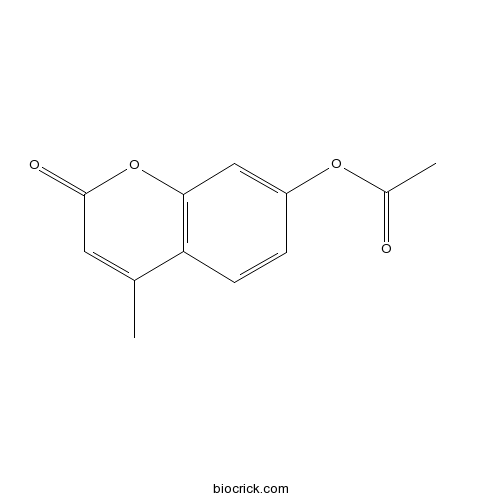7-Acetoxy-4-methylcoumarinCAS# 2747-05-9 |

Quality Control & MSDS
3D structure
Package In Stock
Number of papers citing our products

| Cas No. | 2747-05-9 | SDF | Download SDF |
| PubChem ID | 366 | Appearance | Powder |
| Formula | C12H10O4 | M.Wt | 218 |
| Type of Compound | N/A | Storage | Desiccate at -20°C |
| Solubility | Soluble in Chloroform,Dichloromethane,Ethyl Acetate,DMSO,Acetone,etc. | ||
| Chemical Name | (4-methyl-2-oxochromen-7-yl) acetate | ||
| SMILES | CC1=CC(=O)OC2=C1C=CC(=C2)OC(=O)C | ||
| Standard InChIKey | HXVZGASCDAGAPS-UHFFFAOYSA-N | ||
| Standard InChI | InChI=1S/C12H10O4/c1-7-5-12(14)16-11-6-9(15-8(2)13)3-4-10(7)11/h3-6H,1-2H3 | ||
| General tips | For obtaining a higher solubility , please warm the tube at 37 ℃ and shake it in the ultrasonic bath for a while.Stock solution can be stored below -20℃ for several months. We recommend that you prepare and use the solution on the same day. However, if the test schedule requires, the stock solutions can be prepared in advance, and the stock solution must be sealed and stored below -20℃. In general, the stock solution can be kept for several months. Before use, we recommend that you leave the vial at room temperature for at least an hour before opening it. |
||
| About Packaging | 1. The packaging of the product may be reversed during transportation, cause the high purity compounds to adhere to the neck or cap of the vial.Take the vail out of its packaging and shake gently until the compounds fall to the bottom of the vial. 2. For liquid products, please centrifuge at 500xg to gather the liquid to the bottom of the vial. 3. Try to avoid loss or contamination during the experiment. |
||
| Shipping Condition | Packaging according to customer requirements(5mg, 10mg, 20mg and more). Ship via FedEx, DHL, UPS, EMS or other couriers with RT, or blue ice upon request. | ||

7-Acetoxy-4-methylcoumarin Dilution Calculator

7-Acetoxy-4-methylcoumarin Molarity Calculator
| 1 mg | 5 mg | 10 mg | 20 mg | 25 mg | |
| 1 mM | 4.5872 mL | 22.9358 mL | 45.8716 mL | 91.7431 mL | 114.6789 mL |
| 5 mM | 0.9174 mL | 4.5872 mL | 9.1743 mL | 18.3486 mL | 22.9358 mL |
| 10 mM | 0.4587 mL | 2.2936 mL | 4.5872 mL | 9.1743 mL | 11.4679 mL |
| 50 mM | 0.0917 mL | 0.4587 mL | 0.9174 mL | 1.8349 mL | 2.2936 mL |
| 100 mM | 0.0459 mL | 0.2294 mL | 0.4587 mL | 0.9174 mL | 1.1468 mL |
| * Note: If you are in the process of experiment, it's necessary to make the dilution ratios of the samples. The dilution data above is only for reference. Normally, it's can get a better solubility within lower of Concentrations. | |||||

Calcutta University

University of Minnesota

University of Maryland School of Medicine

University of Illinois at Chicago

The Ohio State University

University of Zurich

Harvard University

Colorado State University

Auburn University

Yale University

Worcester Polytechnic Institute

Washington State University

Stanford University

University of Leipzig

Universidade da Beira Interior

The Institute of Cancer Research

Heidelberg University

University of Amsterdam

University of Auckland

TsingHua University

The University of Michigan

Miami University

DRURY University

Jilin University

Fudan University

Wuhan University

Sun Yat-sen University

Universite de Paris

Deemed University

Auckland University

The University of Tokyo

Korea University
- LE 300
Catalog No.:BCC7148
CAS No.:274694-98-3
- Ticagrelor
Catalog No.:BCC4975
CAS No.:274693-27-5
- Neocryptotanshinone II
Catalog No.:BCN3138
CAS No.:27468-20-8
- Xanthohumol D
Catalog No.:BCN5162
CAS No.:274675-25-1
- 5-Methoxyisatin
Catalog No.:BCC8098
CAS No.:39755-95-8
- Coumarin 7
Catalog No.:BCC8920
CAS No.:27425-55-4
- Picroside I
Catalog No.:BCN6322
CAS No.:27409-30-9
- threo-Guaiacylglycerol
Catalog No.:BCN5161
CAS No.:27391-16-8
- 4'-Hydroxy-7-methoxyflavan
Catalog No.:BCN3497
CAS No.:27348-54-5
- VX-765
Catalog No.:BCC3648
CAS No.:273404-37-8
- Precyasterone
Catalog No.:BCN2754
CAS No.:27335-85-9
- 5-Formyl-2-furylboronic acid
Catalog No.:BCC8748
CAS No.:27329-70-0
- H-Leu-OtBu.HCl
Catalog No.:BCC2974
CAS No.:2748-02-9
- O-Benzyldauricine
Catalog No.:BCC8222
CAS No.:2748-99-4
- Cyclo(D-Val-L-Pro)
Catalog No.:BCN4015
CAS No.:27483-18-7
- trans-4-Aminocyclohexanol
Catalog No.:BCC9181
CAS No.:27489-62-9
- L-Ala-ol
Catalog No.:BCC2590
CAS No.:2749-11-3
- 2-O-Acetyltutin
Catalog No.:BCN5163
CAS No.:2749-28-2
- Vildagliptin (LAF-237)
Catalog No.:BCC2112
CAS No.:274901-16-5
- Protostemonine
Catalog No.:BCN8172
CAS No.:27495-40-5
- Physalin C
Catalog No.:BCN7918
CAS No.:27503-33-9
- O-Methylpallidine
Catalog No.:BCN3916
CAS No.:27510-33-4
- Mesaconitine
Catalog No.:BCN5987
CAS No.:2752-64-9
- Gambogic acid
Catalog No.:BCN2318
CAS No.:2752-65-0
Downregulation of Rubisco Activity by Non-enzymatic Acetylation of RbcL.[Pubmed:27109602]
Mol Plant. 2016 Jul 6;9(7):1018-27.
Atmospheric carbon dioxide (CO2) is assimilated by the most abundant but sluggish enzyme, ribulose-1,5-bisphosphate carboxylase/oxygenase (Rubisco). Here we show that acetylation of lysine residues of the Rubisco large subunit (RbcL), including Lys201 and Lys334 in the active sites, may be an important mechanism in the regulation of Rubisco activities. It is well known that Lys201 reacts with CO2 for carbamylation, a prerequisite for both carboxylase and oxygenase activities of Rubisco, and Lys334 contacts with ribulose-1,5-bisphosphate (RuBP). The acetylation level of RbcL in plants is lower during the day and higher at night, inversely correlating with the Rubisco carboxylation activity. A search of the chloroplast proteome database did not reveal a canonical acetyltransferase; instead, we found that a plant-derived metabolite, 7-Acetoxy-4-methylcoumarin (AMC), can non-enzymatically acetylate both native Rubisco and synthesized RbcL peptides spanning Lys334 or Lys201. Furthermore, lysine residues were modified by synthesized 4-methylumbelliferone esters with different electro- and stereo-substitutes, resulting in varied Rubisco activities. 1-Chloroethyl 4-methylcoumarin-7-yl carbonate (ClMC) could transfer the chloroethyl carbamate group to lysine residues of RbcL and completely inactivate Rubisco, whereas bis(4-methylcoumarin-7-yl) carbonate (BMC) improved Rubisco activity through increasing the level of Lys201 carbamylation. Our findings indicate that RbcL acetylation negatively regulates Rubisco activity, and metabolic derivatives can be designed to dissect and improve CO2 fixation efficiency of plants through lysine modification.


